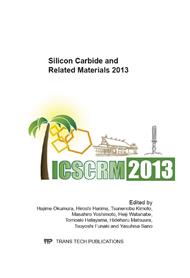[1]
M.B.J. Wijesundara, and R.G. Azevedo, Silicon Carbide Microsystems for Harsh Environments, Springer, (2011).
Google Scholar
[2]
D. G. Senesky, B. Jamshidi, K. B. Cheng, and A. P. Pisano, Harsh Environment Silicon Carbide Sensors for Health and Performance Monitoring of Aerospace Systems: a Review, IEEE Sensors Journal, vol. 9, no. 11, pp.1472-1478, (2009).
DOI: 10.1109/jsen.2009.2026996
Google Scholar
[3]
P.G. Neudeck, Progress in Silicon Carbide Semiconductor Electronics Technology, Journal of Electron Material, vol. 24, no. 4, pp.283-288, (1995).
Google Scholar
[4]
P.G. Neudeck, R.S. Okojie, and L. -Y. Chen, High-Temperature Electronics – A Role for Wide Bandgap Semiconductors, Proceedings of the IEEE, vol. 90, no. 6, pp.1065-1076, (2002).
DOI: 10.1109/jproc.2002.1021571
Google Scholar
[5]
P. G. Neudeck, SiC Technology, in The VLSI Handbook, Second Edition, Florida: CRC Press, p.5. 1-5. 34, (2007).
Google Scholar
[6]
A.C. Patil, X. -A. Fu, C. Anupongongarch, M. Mehregany, and S. Garverick, Characterization of Silicon Carbide Differential Amplifiers at High Temperature, Compound Semiconductor Integrated Circuit Symposium 2007 (CSIC 2007, IEEE), pp.1-4, (2007).
DOI: 10.1109/csics07.2007.33
Google Scholar
[7]
L. Lanni, R. Ghandi, B.G. Malm, C. -M. Zetterling, and M. Ostling, Design and Characterization of High-Temperature ECL-Based Bipolar Integrated Circuits in 4H-SiC, Electron Devices, IEEE Transactions on , vol. 59, no. 4, pp.1076-1083, (2012).
DOI: 10.1109/ted.2011.2182514
Google Scholar
[8]
H. -S. Lee, M. Domeij, C. -M. Zetterling, M. Ostling, F. Allerstam, and E.O. Sveinbjornsson, Surface passivation oxide effects on the current gain of 4H-SiC bipolar junction transistors, Applied Physics Letters, no. 92, p.082113, (2008).
DOI: 10.1063/1.2888965
Google Scholar
[9]
H. Miyake, T. Kimoto, and J. Suda, Improvement of Current Gain in 4H-SiC BJTs by Surface Passivation With Deposited Oxides Nitrided in N2O or NO, Electron Device Letters, IEEE , vol. 32, no. 3, pp.285-287, (2011).
DOI: 10.1109/led.2010.2101575
Google Scholar
[10]
S. Balachandran, T.P. Chow, and A. Agarwal, Low and High Temperature Performance of 600V 4H-SiC Epitaxial Emitter BJTs, Material Science Forum, vols. 483-485, pp.909-912, (2005).
DOI: 10.4028/www.scientific.net/msf.483-485.909
Google Scholar
[11]
X. Li, Y. Luo, L. Fursin, J.H. Zhao, M. Pan, P. Alexandrov, and M. Weiner, On the temperature coefficient of 4H-SiC BJT current gain, Solid-State Electronics, vol. 47, pp.233-239, (2003).
DOI: 10.1016/s0038-1101(02)00200-9
Google Scholar


